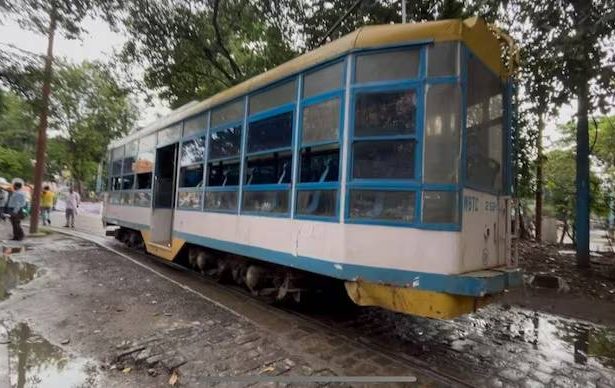Kolkata’s Iconic Trams: Kolkata, often hailed as the city of trams, is set to bid farewell to its 150-year-old iconic tram service, with the West Bengal government deciding to discontinue tram operations across the city. This decision marks the end of an era for Kolkata’s trams, which have been an integral part of the city’s history and culture since the 19th century. While one heritage tram route will continue, the majority of tram services will soon disappear from the streets, primarily due to increasing vehicular traffic and road congestion.
The End of an Era for Kolkata’s Iconic Trams
West Bengal Transport Minister Snehasis Chakraborty announced that Kolkata’s trams, which have been struggling to survive in the face of modern transportation, will soon be discontinued. According to Chakraborty, the city’s narrow roads and rising vehicular traffic have made it difficult for trams to coexist with other forms of transportation. The presence of trams on congested routes has been contributing to traffic jams, especially during peak hours, leading the government to take this difficult decision.
“To ensure that people don’t face delays during office hours due to traffic jams, we’ve decided to withdraw trams from most routes. However, there will still be a well-equipped heritage tram for joyrides running from Esplanade to Maidan,” said Chakraborty.
This decision comes as tram services have already been discontinued on several key routes in the city. In fact, by 2022, only two routes remained operational, down from 37 routes in 2011. The state’s transport department has ceased investing in tram infrastructure since 2018, which has contributed to the decline of this once-flourishing mode of transportation.
Tram Route Reduction and Decline in Passengers
The decline of trams in Kolkata has been a gradual process. At one point, the city had an extensive tram network covering 61 kilometers of track. By 2022, this figure had shrunk to just 12 kilometers. The number of passengers using the tram has also dwindled significantly. In 2011, over 70,000 people used the tram system daily, but today, that number has fallen to just five to seven thousand.
The workforce behind the trams has similarly declined. In 2011, approximately 7,000 workers were employed to operate the city’s tram network. However, due to route closures and a lack of investment, the number of workers has dropped to zero, with the trams no longer requiring dedicated staff on most routes.
The COVID-19 pandemic further accelerated the decline of the tram system. Several routes were permanently closed during this period, leaving only two operational routes by the end of 2022.
Heritage Trams: A Glimpse of the Past
Despite the widespread discontinuation, a slice of Kolkata’s tram history will remain. The government plans to preserve a heritage tram route running from Esplanade to Maidan. This route will serve as a joyride for tourists and residents who wish to experience the nostalgic charm of Kolkata’s trams. The heritage tram will be well-maintained and equipped to provide an authentic experience, keeping the legacy of trams alive in some form.
However, the majority of tram routes will no longer be operational, as the government prioritizes reducing traffic congestion and improving travel times in the bustling city. According to Chakraborty, it was a necessary decision to enhance the flow of vehicular traffic and ensure that commuters don’t face delays due to tram-related roadblocks.
Legal and Environmental Concerns
The discontinuation of Kolkata’s trams has not gone unchallenged. A petition regarding the operation of trams is currently pending in the Calcutta High Court, with suggestions from the court indicating that a public-private partnership (PPP) model could be explored to rejuvenate and restore tram services. However, the state government has yet to make significant efforts to pursue this option.
Various environmental and heritage organizations have also raised objections to the government’s decision. The Calcutta Tram Users Association (CUTA) has been at the forefront of protests against the move. The organization plans to hold demonstrations at five tram depots across the city to voice their discontent, citing the historical and environmental significance of trams in Kolkata.
Trams have long been regarded as an eco-friendly mode of transport, operating on electricity and producing zero emissions. Environmental groups have argued that discontinuing tram services could lead to increased pollution in the city, as more cars and buses will be on the roads to fill the transportation gap left by trams.
A Rich History Comes to a Close
Trams have been an integral part of Kolkata’s identity for over 150 years. The first horse-drawn tram was introduced in the city in 1873, and since then, the tram system has played a significant role in shaping Kolkata’s urban landscape. Over the years, trams have become a symbol of the city’s heritage, offering a slower, more relaxed way to travel through its streets.
However, as modern transportation evolved and the city’s traffic increased, the once-popular tram system became less viable. Despite the nostalgia attached to them, the practicality of maintaining trams in today’s Kolkata has been called into question, ultimately leading to their near-total discontinuation.
Kolkata’s decision to discontinue its iconic tram service, except for a single heritage route, marks the end of an era. The state government’s move to remove trams from the city’s roads comes as a response to increasing traffic congestion and narrow roads that can no longer accommodate this mode of transport. While a heritage tram will continue to operate as a joyride for tourists, the city will soon lose the majority of its tram network, closing a chapter in Kolkata’s rich history.


